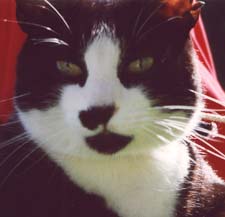|
D -- A -- O -- B -- S -- letters are colors in cats
by Terri Hobbs
Glossy black and crisp white -- your b & w cat is beautiful. But
how did he or she end up that way?
Basically, a cat's color is
determined by its genes. Each cat gets a copy of its genes from its mother
and another from its father; so each cat has two copies of its genes. With
the exception of the X and Y chromosomes -- Females have 2 X chromosomes,
and males have X and Y. So any genes on the X chromosome only occur once
in males.

Tully
Genes are named by letters, like B. And, a given gene can have different forms;
these forms have different effects. Often, one form dominates the others.
In that case, the gene letter of the dominant form is the capital letter: B.
The non-dominant form is indicated by a lower case letter: b. If B and b
occur together in a kitty, the B will take effect over the b.

Boots
|
Many genes determine a cat's color. One gene, for example, controls the
density of the pigment in the hair. This gene is called D. D means the darker,
denser pigment, while d is another form of the same gene that makes the
pigment less dense and causes a lighter color.
|
A kitty that has two D's or
a D and a d will have dense color. In order for a cat to be black, it has
to have a D -- otherwise it will be gray.
Another gene will make a cat a tabby -- or a solid color. This gene is called A.
In this case, if a cat has two A's or A and a, it will be a tabby because
the individual hairs will have bands of colors. Only if the cat has two
copies of the non-tabby form of the gene -- aa -- will it be a solid color,
like all black.

Percy
But some cats are orange/red or tortoiseshell -- so what causes the
color black? Here two genes are involved -- B and O. The gene O is
one of those genes that only shows up on the X chromosome. And it
makes the orange color appear -- or not. If a male cat, who can only
have one copy of O, has the O form, it will be orange/red no matter
what the B gene is doing. If the male has the o form, the B gene
can take effect. A female cat, who can have two copies of the O gene,
must be OO to be all orange/red, or oo for the B gene to work. A female
with Oo will be a tortoiseshell (both orange/red and black).
OK -- what about the B gene itself? If the B form is present as BB or B and
b, the cat will be black. If both copies are bb, the cat will be brown.
|
So far, we know a black and white cat must have D to make dark, dense
pigment in the hair, and o (or oo) to let the B gene work, and B to
make the black color.
|

Socks
|
Now for white. In the case of a black and white cat, the S, spotting, gene
is operating. S masks color -- the white is the absence of color. S doesn't
work 100%, however. If a cat has S it will not be completely white, but
only partially. The effect of S varies too, so some cats only have white
mittens, but others are nearly completely white.

Big Kitty
There is one last gene not mentioned -- C. This gene makes the entire cat
all one color, as opposed to different shades like Siamese (darker on the
nose, paws, and tail, lighter on the body). So a black and white cat will
also have C.
Black and white cat: B- D- aa o(o) Ss(or SS) C-
Gray and white cat: B- dd aa o(o) Ss(or SS) C-

Missy
Terri is webmaster of this site and this article is Copyright 2007. Information
was obtained from:
The Readerís Digest Illustrated Book of Cats, The Reader's Digest Association (Canada) Ltd.,
Montreal, 1992, pp. 142-151.
|



